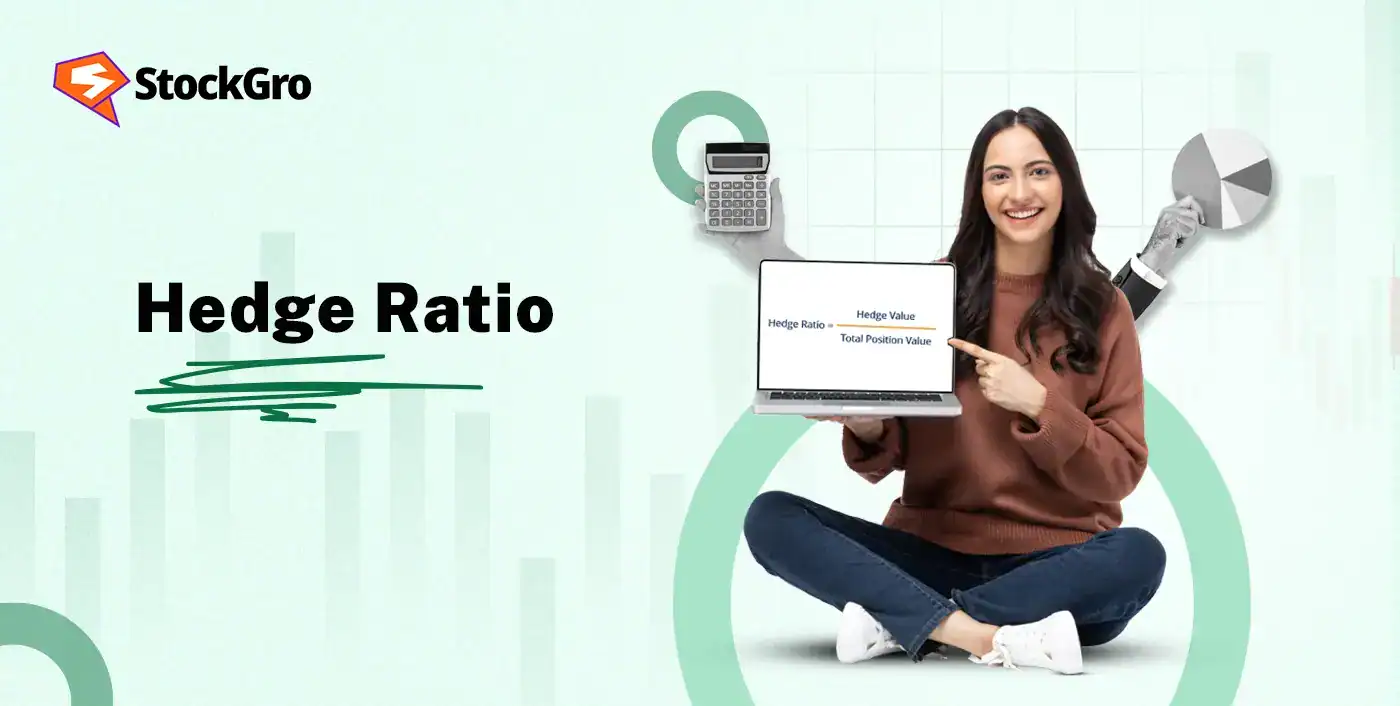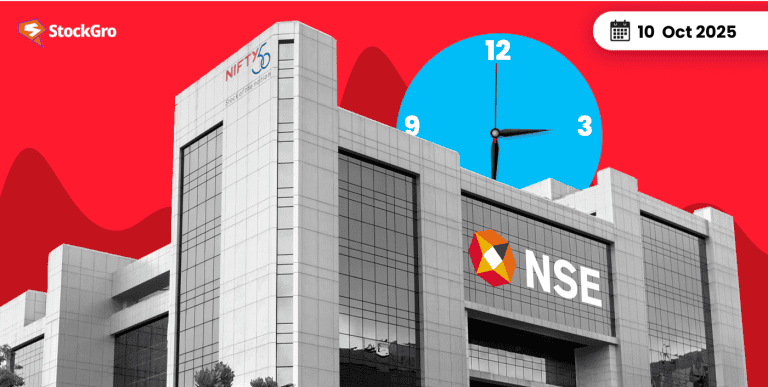
You’ve invested your money in stocks or gold, and now you are hoping it grows over time. But suddenly, prices crash overnight.
Now, what if there was a way to protect yourself from such surprises? That’s what the hedge ratio helps with. It tells you how much of your investment is covered or protected from market ups and downs.
Want to know more about the hedge ratio? Let’s see it here.
What is a hedge ratio?
A hedge ratio shows how much of your investment is protected. It tells you how much risk in your main investment is covered by another position you’ve taken to reduce possible losses.
Here’s how hedge ratio calculation is done.
Formula and calculation examples
The hedge ratio formula is simple:
Hedge Ratio = Value of Hedge ÷ Total Value of Investment
- Value of Hedge: How much you’ve put into the protection.
- Total Value of Investment: How much your main position is worth.
What the Numbers Mean
- 1 or 100%: Fully protected.
- 0: Not protected at all.
- Between 0 and 1: Partially protected.
- Above 1: Over-protected, more than needed.
Example 1: Currency Hedging
Investor holds: ₹10,00,000 in international mutual funds.
Hedge Ratio in derivatives: ₹3,00,000.
Hedge Ratio: 3,00,000 ÷ 10,00,000 = 30%
This means 30% of the portfolio is protected against currency fluctuations.
Example 2: Stock Hedging with Options
Investor holds: ₹2,00,000 worth of a company’s shares.
Buys put options to hedge: ₹1,20,000 of the stock’s value.
Hedge Ratio: 1,20,000 ÷ 2,00,000 = 60%
Here, 60% of the stock position is protected.
Example 3: Forward Contracts for Currency Risk
Portfolio Value: ₹50,00,000 held in USD investments.
Sells forward contracts: ₹25,00,000 to hedge against INR/USD changes.
Hedge Ratio: 25,00,000 ÷ 50,00,000 = 50%
Half of the portfolio is protected from currency swings.
Importance in risk management
Check out why risk management is important for you:
1. Helps Manage Risk
The hedge ratio tells you what part of your investment is covered. A ratio of 1 (or 100%) means you’ve fully protected your position.
A lower ratio, say 0.5, means only half is covered. It’s a way to balance between safety and still having a chance to earn more if prices move in your favor.
2. Helps You Find the Right Amount of Cover
Not everyone wants to hedge everything. The hedge ratio helps you figure out the best number of contracts to use for protection.
It’s especially helpful when you’re using one asset to hedge another that’s similar but not exactly the same, like using oil futures to hedge a fuel business.
3. Lets You Hedge Partly
You don’t always have to cover everything. Some investors prefer to hedge part of their holdings and still give them a chance to benefit if prices move their way.
4. Making Portfolio Better
The hedge ratio helps make your portfolio stronger. In stock portfolios, people use something called a beta-adjusted ratio to manage ups and downs.
In options, a delta-adjusted ratio helps control how much the option’s value changes when the market moves.
5. Supports Dynamic Strategies
Hedge ratios don’t stay the same all the time. They can change as the market moves or as your comfort with risk changes.
They help you avoid being overprotected or underprotected when prices, volatility, or trading activity change.
Applications in futures, options, and derivatives
If you use futures, options, or other derivatives, the hedge ratio is one number you should really know. It basically shows how much of your position is protected from market ups and downs.
1. In Futures
It helps you decide how many futures contracts to take to protect your position. Investors often use it to handle market swings.
The hedge ratio also helps you find the right number so you are covered but not overdoing it. It also makes you see how your protection will change if the market moves.
2. In Options
Here, the hedge ratio tells you how many options you need to stay protected from price changes. It’s super useful in the options trading as prices are volatile.
The ratio can change every day as prices move. That means your protection can get weaker or stronger without you noticing.
3. In Other Derivatives
From forwards to swaps, this ratio helps you check how much of your risk is actually covered and how well your hedge is working.
If the hedge ratio is off, you could still lose money. This ratio helps you see how much risk is left and how well your hedge is working. It also makes you understand how all the different derivatives in your portfolio work together so you can manage risk better.
Optimal vs. minimum hedge ratios
If people use futures, options, or other contracts to protect their investments, they often hear two terms: minimum hedge ratio and optimal hedge ratio.
Both help reduce risk, but they do it in slightly different ways.
1. Minimum Hedge Ratio
This one is all about cutting down risk as much as possible. It tells you how much of your position to hedge so that your losses are the smallest if prices move against you. Minimum hedge ratio doesn’t care about how much profit you might make.
2. Optimal Hedge Ratio
The optimal hedge ratio looks at both risk and return. It tries to find a middle ground and protect you from losses while still giving you a chance to earn more.
It’s harder to calculate because it depends on things like your comfort with risk and what kind of returns you expect. So, it’s different for every investor.
Limitations and assumptions
Hedge ratios have some limits and rely on certain ideas:
Limitations
- Market changes: Prices, volatility, and correlation can change anytime.
- Basis risk: Basis risk means your hedge and your asset don’t always change in the same way, so the hedge might not fully protect you from losses.
- Minimum ratio ignores returns: You might miss profits if you work only on reducing variance.
- Personal risk comfort: That’s hard to measure exactly.
- Need review: Ratios should be updated as markets and your positions change.
- Can’t remove all risks: Things like liquidity issues or sudden news can still affect you.
Assumptions
- Spot position: A lot of models assume your asset amount is fixed. This won’t make the hedge better than the model predicts.
- Infinitely risk-averse: Classical models ignore expected returns. They only work if you are extremely cautious or if futures prices never change.
- Normal returns: This can make the calculated hedge ratio less accurate or “optimal” than expected.
- Constant Volatility: Volatility can spike and correlations can shift during market turbulence.
Wrapping Up
A hedge ratio is a way to see how much of your investment is protected from big market changes using tools like futures or options. A ratio of 1 means you are fully protected, 0 means no protection, and anything in between shows partial coverage.
It helps investors decide how much to cover so they don’t lose too much if prices drop, but still have a chance to earn. Hedge ratios are used in stocks, currencies, and other investments. But they aren’t perfect because markets and risks keep changing.
FAQs
A hedge ratio It tells you exactly how much of your investment is safe if the market swings. A ratio of 1 means fully protected, 0 means no protection, and anything in between is partial cover. It’s a good way of balancing risk and reward. Apart from this, it will also avoid big losses but still leave room to make money when prices change a lot in the stock market.
You can do the calculation of the hedge ratio by dividing the value of your hedge by the total value of your investment. So, if you have ₹1,00,000 in stocks and buy ₹30,000 worth of futures to protect it, the hedge ratio is 0.3.
You don’t have to fully protect your money as the optimal hedge ratio will avoid big losses. It will still make you earn if prices go up as per how your asset and hedge move together.
Without a hedge ratio, you could guess how much to protect and end up losing more than expected. They show how much of your money is protected if markets drop. It helps you decide if you want partial or full protection and keeps your portfolio from losing too much.
In futures, the hedge ratio tells you how many contracts to buy or sell to protect your position. Farmers, exporters, and investors use it to avoid big losses. In options, it shows how many options you need to cover your investment. It can make you reduce your risk when prices jump around. The ratio also tells you if your hedge is working the way it should.
Hedge ratios are not perfect. They assume things like stable prices or fixed positions, but real markets can change suddenly. The wrong ratio can either protect your funds too much or not. Also, volatility, correlations, and risk can make the hedge less useful. You need to check it often because it cannot remove all risks or guarantee exact results.
AI can help by looking at lots of market data quickly and suggesting the best hedge level. It can watch prices, risks, and how things move together, and suggest how much of your money to protect. But it’s not magic. You still need to understand its suggestions and make the final call. AI can give you guidance and save time, but your own judgment can keep your money safe and helps you make smarter choices.

